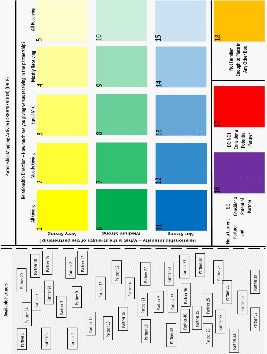Evaluation of National Park Service Presence in Urban Areas
Programmatic Review and Clearance Process for NPS-Sponsored Public Surveys
UrbanAgenda_InterviewGuidePartnershipMapping
Evaluation of National Park Service Presence in Urban Areas
OMB: 1024-0224
PAPERWORK REDUCTION ACT STATEMENT: The National Park Service is authorized by 16 U.S.C. 1a-7 to collect this information. This information will be used by National Park Service managers to understand the public’s perceptions about and engagements with National Park Service parks, programs, and partnerships in urban areas. Response to this request is voluntary. No action may be taken against for refusing to supply the information requested. The permanent data will be anonymous. An agency may not conduct or sponsor, and a person is not required to respond to, a collection of information unless it displays a currently valid OMB control number.
BURDEN ESTIMATE statement: Public reporting burden for this form is estimated to be 90 minutes per completed response. Direct comments regarding the burden estimate or any other aspect of this form to: Rebecca Stanfield McCown, Program Manager, Stewardship Institute, 54 Elm St, Woodstock, VT 05091; 802-457-3368 ext 19; rebecca_stanfield_mccown@nps.gov (email).
Interview
Hi ______, thank you for speaking for me today. Today I’d like to hear about your opinions about and experiences with the NPS parks, programs, and partnerships in your area. There are nine questions and it should take about 90 minutes. Let’s get started.
Please describe your experience and what you do and your experiences in your organization?
Please describe your organization’s history with the NPS.
How would you describe the NPS presence in the region?
Probe: Which, if any, sites and/or programs are you familiar with?
What impact has the NPS had on your organization’s area of focus?
In your opinion, what do you think is the ideal role for the NPS to play in serving the public and surrounding communities?
Probe: What do you think are some of the strengths and assets the NPS has to offer?
When thinking about work accomplished with partners, what initiatives come to mind as being particularly successful?
As you may know, the NPS is implementing an Urban Agenda that is focused on understanding their presence and involvement in urban areas like this one.
The following three principles have been laid out for the Urban Agenda:
Be relevant to all Americans,
Activate “One NPS” (integrate/emphasize all NPS parks, programs, and partnerships), and
Nurture a culture of collaboration.
Please tell me, how you see these principles integrating with your work?
A goal of the Urban Agenda is to contribute to resilient cities. What ways do you see the NPS contributing to the resiliency in this area?
Probe: What components do you think are needed for this area to be a resilient city?
This project is just getting started. How would you like to see an Urban Agenda implemented here? What would it take for it to be successful?
Do you have any questions?, If you should have any later on today please feel free to contact me at (XXX) XXX-XXXX. Thank you for your time and input.
PAPERWORK REDUCTION ACT STATEMENT: The National Park Service is authorized by 16 U.S.C. 1a-7 to collect this information. This information will be used by National Park Service managers to understand the public’s perceptions about and engagements with National Park Service partnerships in urban areas. Response to this request is voluntary. No action may be taken against for refusing to supply the information requested. The permanent data will be anonymous. An agency may not conduct or sponsor, and a person is not required to respond to, a collection of information unless it displays a currently valid OMB control number.
BURDEN ESTIMATE statement: Public reporting burden for this form is estimated to be 20 minutes per completed response. Direct comments regarding the burden estimate or any other aspect of this form to: Rebecca Stanfield McCown, Program Manager, Stewardship Institute, 54 Elm St, Woodstock, VT 05091; 802-457-3368 ext 19; rebecca_stanfield_mccown@nps.gov (email).
Partnership Mapping
Hi _____, thanks for speaking with me today. Today, we’ll do an exercise that asks you to think about your relationships with the NPS and other organizations in the area. It should take about 20 minutes.
As you know, the NPS interacts with many organizations, including yours. They’re interested in learning more from partners about successful relationship strategies and networks. For today’s exercise, I want you to plot out your relationships with other NPS-identified partners on an interactive map. You should have received a link to this interactive mapping tool, yes? Let’s pull it up together (template below).
OK, here’s what you’ll do. You’ll move each “partner” from the “Available Partners” location on the left to one of the locations on the right. You have three general areas to decide among for where you’ll move each partner:
If a relationship exists, decide how you’d characterize the intensity and direction of the relationship, locations 1-15. Intensity refers to how you perceive the strength of the relationship. Direction refers to the exchange of inputs and outputs for your organization in the relationship.
If a relationship does not exist, decide how you’d characterize the future partnership potential, locations 16 and 17.
If you’re unable to decide among any of those locations because you’re unfamiliar with a partner, there’s a map location, #18, for that response.
Do you have any questions?
I’ll stay on the phone, in case you have any questions while completing the exercise.
Let’s begin.
After exercise: Do you have any questions?, If you should have any later on today please feel free to contact me at (XXX) XXX-XXXX. Thank you for your time and input.

| File Type | application/vnd.openxmlformats-officedocument.wordprocessingml.document |
| Author | Bess Perry |
| File Modified | 0000-00-00 |
| File Created | 2021-01-27 |
© 2025 OMB.report | Privacy Policy